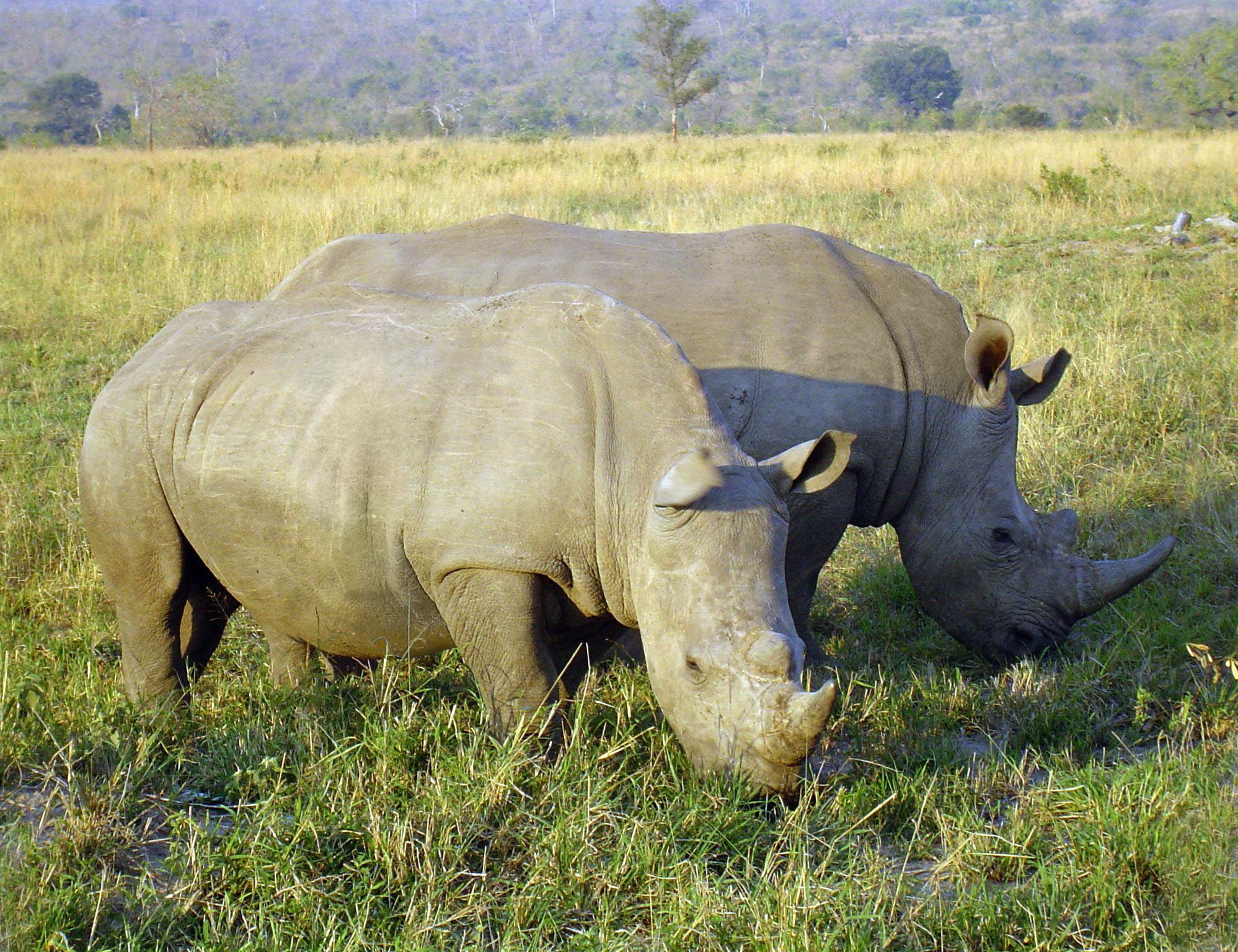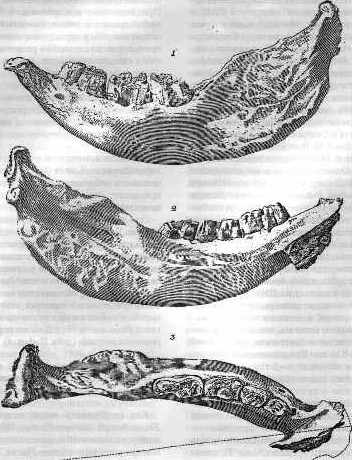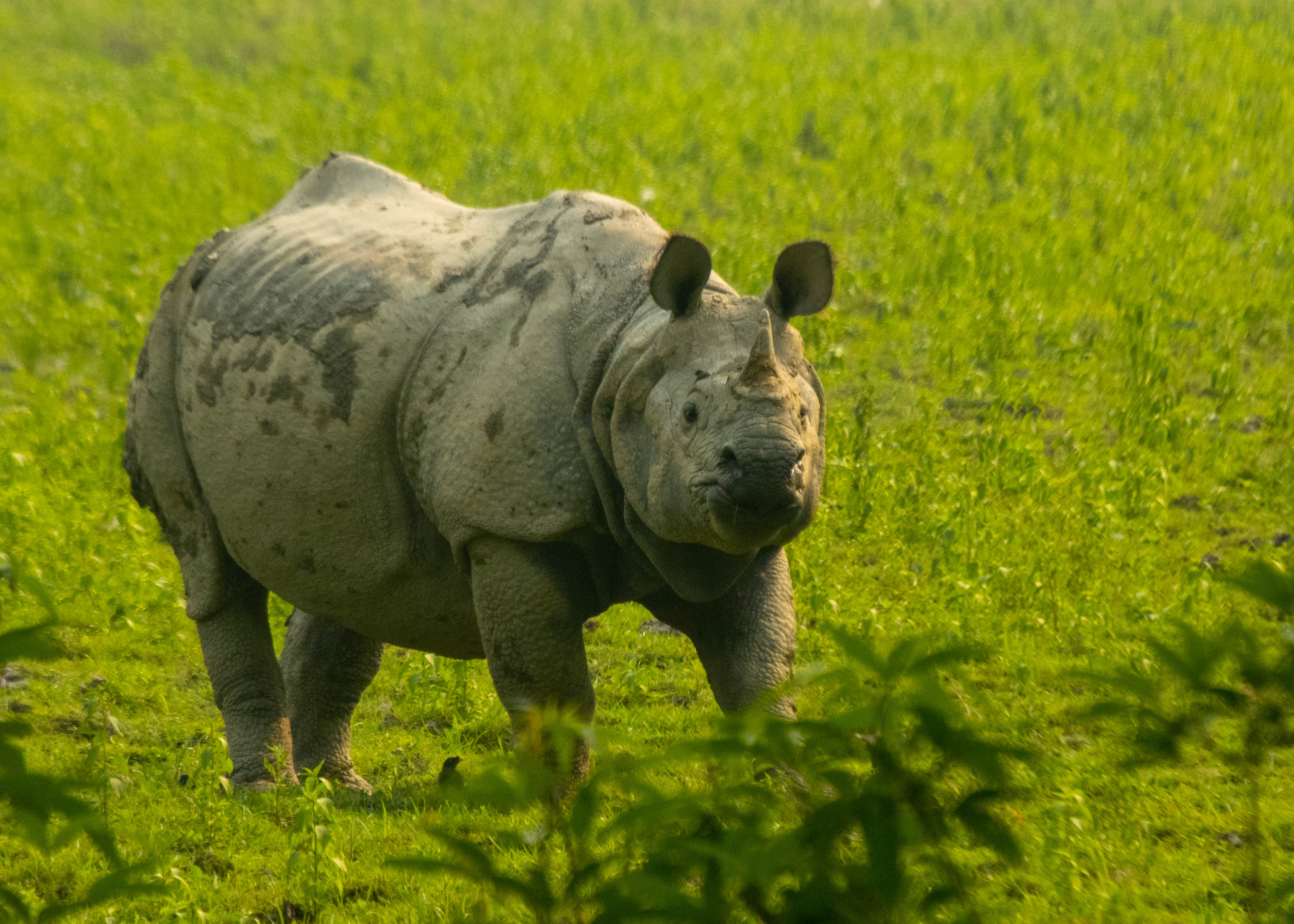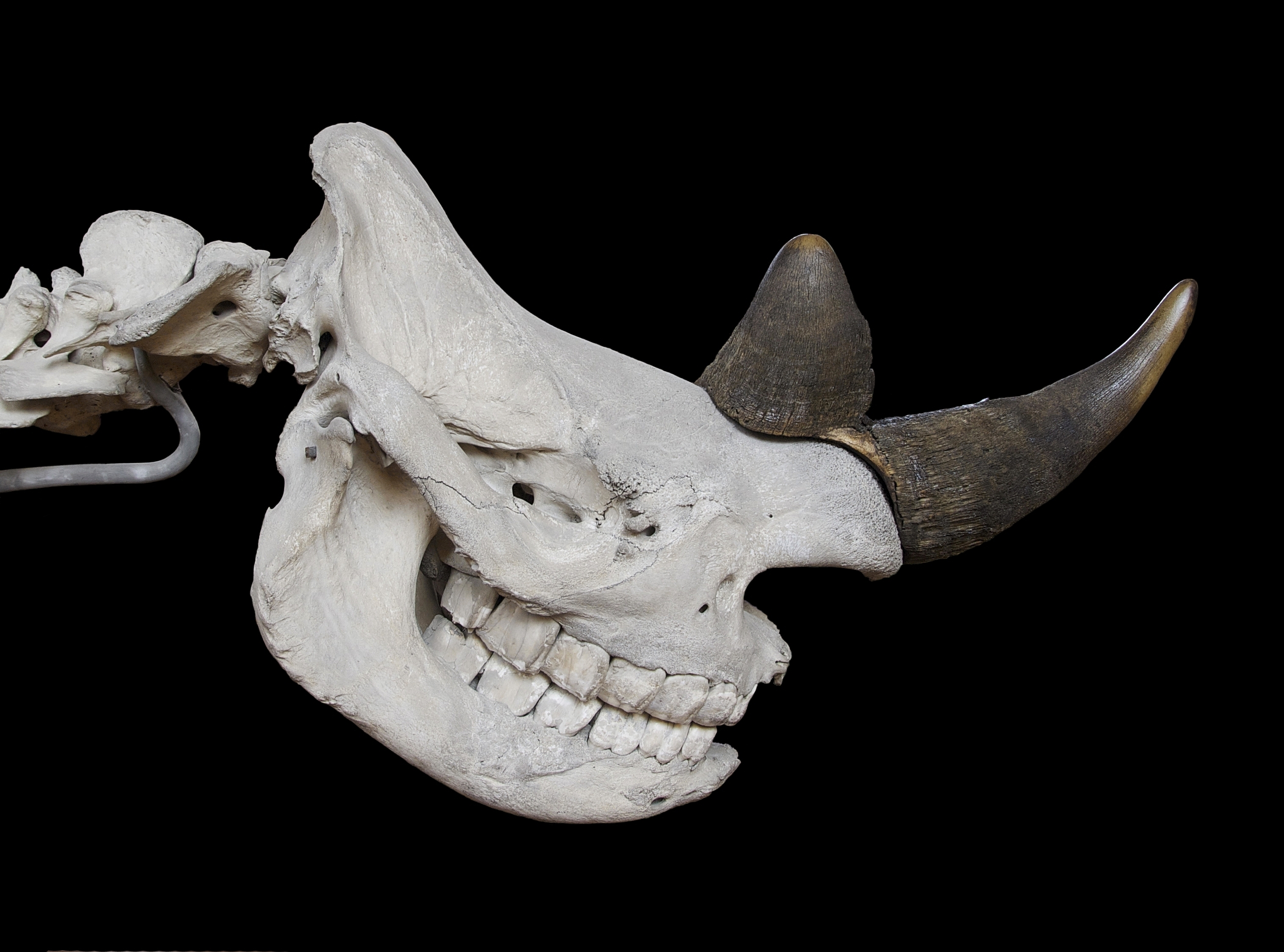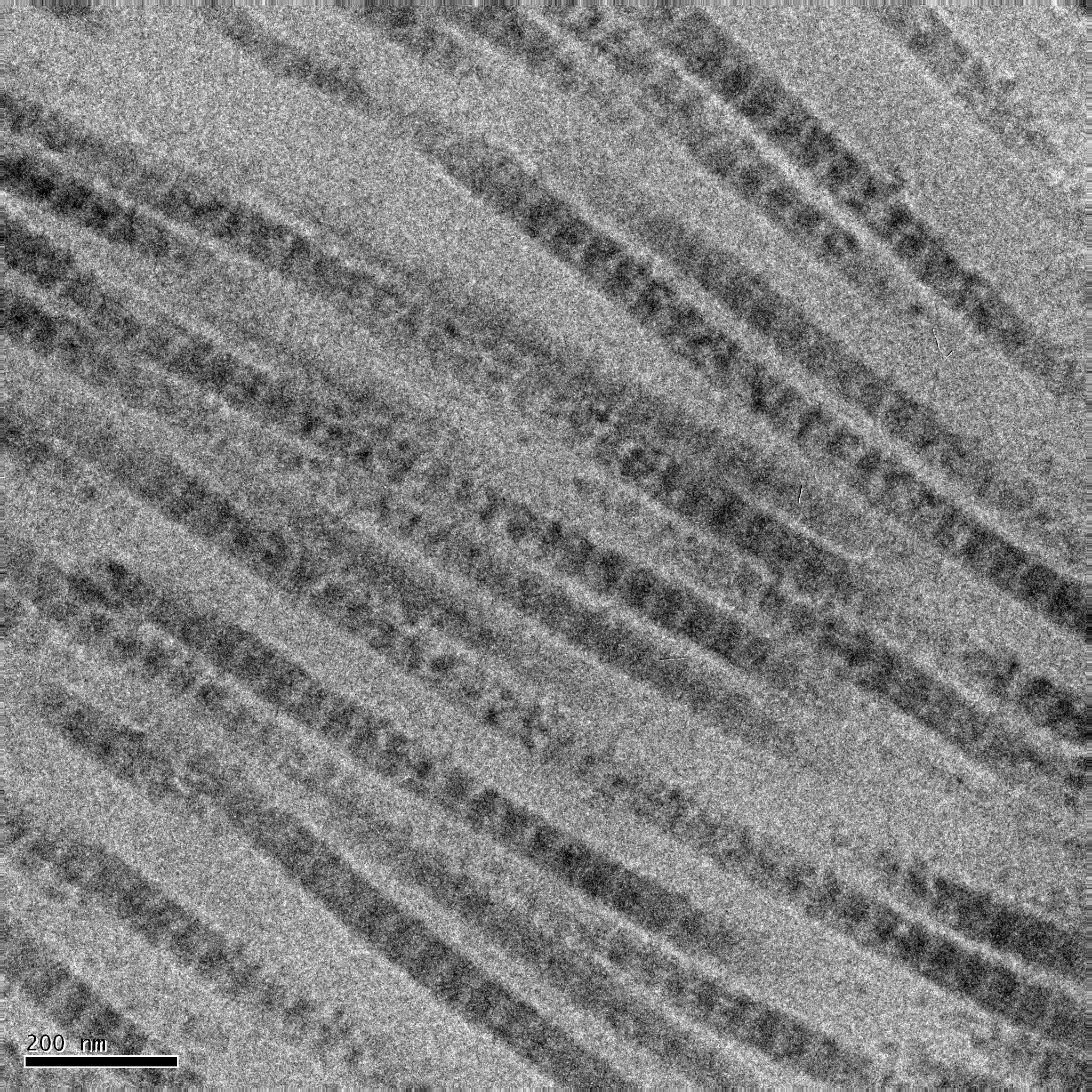|
Rhinoceroses
A rhinoceros ( ; ; ; : rhinoceros or rhinoceroses), commonly abbreviated to rhino, is a member of any of the five extant taxon, extant species (or numerous extinct species) of odd-toed ungulates (perissodactyls) in the family (biology), family Rhinocerotidae; it can also refer to a member of any of the extinct species of the superfamily Rhinocerotoidea. Two of the extant species are native to Africa, and three to South Asia, South and Southeast Asia. Rhinoceroses are some of the largest remaining megafauna: all weigh over half a tonne in adulthood. They have a herbivore, herbivorous diet, small brains for mammals of their size, one or two horns, and a thick , protective skin formed from layers of collagen positioned in a crystal structure, lattice structure. They generally eat leafy material, although their ability to ferment food in their colon (anatomy), hindgut allows them to subsist on more fibrous plant matter when necessary. Unlike other perissodactyls, the two African ... [...More Info...] [...Related Items...] OR: [Wikipedia] [Google] [Baidu] |
White Rhinoceros
The white rhinoceros, also known as the white rhino or square-lipped rhinoceros (''Ceratotherium simum''), is the largest extant species of rhinoceros and the most Sociality, social of all rhino species, characterized by its wide mouth adapted for grazing (behaviour), grazing. The species includes two subspecies with dramatically different conservation outlooks: the southern white rhinoceros, with an estimated 17,464 individuals in the wild as of the end of 2023, and the northern white rhinoceros. The northern subspecies is critically endangered and on the brink of extinction; its last known male, Sudan (rhinoceros), Sudan, died in March 2018, leaving behind only a very small number of females in captivity. Both subspecies have faced significant threats, primarily from poaching for their horns and habitat loss, which contribute to the species' overall Conservation status, conservation status of Near Threatened. Naming One popular, though widely discredited, theory for the origi ... [...More Info...] [...Related Items...] OR: [Wikipedia] [Google] [Baidu] |
Elasmotherium
''Elasmotherium'' is an extinct genus of large rhinoceros that lived in Eastern Europe, Central Asia and East Asia during Late Miocene through to the Late Pleistocene, with the youngest reliable dates of at least 39,000 years ago. It was the last surviving member of Elasmotheriinae, a distinctive group of rhinoceroses separate from the group that contains living rhinoceros (Rhinocerotinae). Five species are recognised. The genus first appeared in the Late Miocene in present-day China, likely having evolved from '' Sinotherium'', before spreading to the Pontic–Caspian steppe, the Caucasus and Central Asia. The best known ''Elasmotherium'' species, ''E. sibiricum'', sometimes called the Siberian unicorn, was among the largest known rhinoceroses, with an estimated body mass of around , comparable to an elephant, and is often conjectured to have borne a single very large horn. However, no horn has ever been found, and other authors have conjectured that the horn was likely ... [...More Info...] [...Related Items...] OR: [Wikipedia] [Google] [Baidu] |
Indian Rhinoceros
The Indian rhinoceros (''Rhinoceros unicornis''), also known as the greater one-horned rhinoceros, great Indian rhinoceros or Indian rhino, is a species of rhinoceros found in the Indian subcontinent. It is the second largest living rhinoceros species, with adult males weighing and adult females . Its thick skin is grey-brown with pinkish skin folds. It has a single horn on its snout that grows up to long. Its upper legs and shoulders are covered in wart-like bumps, and it is nearly hairless aside from the eyelashes, ear fringes and tail brush. The Indian rhinoceros is native to the Indo-Gangetic Plain and occurs in 12 protected areas in northern India and southern Nepal. It is a Grazing (behaviour), grazer, eating mainly grass, but also twigs, leaves, branches, shrubs, flowers, fruits and aquatic plants. It is a largely solitary animal, only associating in the breeding season and when rearing calves. Females give birth to a single calf after a gestation of 15.7 months. Th ... [...More Info...] [...Related Items...] OR: [Wikipedia] [Google] [Baidu] |
Black Rhinoceros
The black rhinoceros (''Diceros bicornis''), also called the black rhino or the hooked-lip rhinoceros, is a species of rhinoceros native to East Africa, East and Southern Africa, including Angola, Botswana, Eswatini, Kenya, Lesotho, Malawi, Mozambique, Namibia, South Africa, Tanzania, Zambia, and Zimbabwe. Although the species is referred to as ''black'', its colours vary from brown to grey. It is the only extant species of the genus ''Diceros''. The other rhinoceros native to Africa is the white rhinoceros (''Ceratotherium simum''). The word "white" in the name "white rhinoceros" is often said to be a misinterpretation of the Afrikaans word ' (Dutch language, Dutch ') meaning wide, referring to its square upper lip, as opposed to the pointed or hooked lip of the black rhinoceros. These species are now sometimes referred to as the square-lipped (for white) or hook-lipped (for black) rhinoceros. The species overall is classified as critically endangered (even though the south-wes ... [...More Info...] [...Related Items...] OR: [Wikipedia] [Google] [Baidu] |
Rhinocerotoidea
Rhinocerotoidea is a superfamily (taxonomy), superfamily of Perissodactyla, perissodactyls that appeared 56 million years ago in the Paleocene. They included four extinct families, the Amynodontidae, the Hyracodontidae, the Paraceratheriidae, and the Eggysodontidae. The only extant family is the Rhinocerotidae (true rhinoceroses), which survives as five living species. Extinct non-rhinocerotid members of the group are sometimes considered rhinoceroses in a broad sense. Although the term 'rhinoceroses' is sometimes used to refer to all of these, a less ambiguous vernacular term for this group is 'rhinocerotoids'. The family Paraceratheriidae contains the largest land mammals known to have ever existed. Taxonomy The cladogram below follows a phylogenetic analysis by Bai ''et al.'' (2020): References {{Authority control Rhinocerotoidea, Ceratomorpha Mammal superfamilies Taxa named by John Edward Gray ... [...More Info...] [...Related Items...] OR: [Wikipedia] [Google] [Baidu] |
Ceratotherium
''Ceratotherium'' (from Greek: ''keras'' κέρας "horn" and ''thērion'' θηρίον "beast") is a genus within the family Rhinocerotidae. It comprises one living species, the white rhinoceros (''Ceratotherium simum''), and several extinct fossil species that trace its evolutionary lineage. Taxonomy and evolution The genus ''Ceratotherium'' belongs to the tribe Dicerotini (also spelled Diceroti) or subtribe Dicerotina, indicating a closer evolutionary relationship to the genus '' Diceros'' (which includes the black rhinoceros) than to other extant rhinoceros genera. The evolutionary history of ''Ceratotherium'' includes several recognized and debated fossil species: * '' Ceratotherium mauritanicum'': An extinct species known from the Pleistocene of North Africa. Some Pliocene East African remains, alternatively attributed by some authors to ''Ceratotherium efficax'', are sometimes included in ''C. mauritanicum''. Depending on the inclusion of these East African materials, ' ... [...More Info...] [...Related Items...] OR: [Wikipedia] [Google] [Baidu] |
Diceros
''Diceros'' (Greek: "two" (dio), "horn" (keratos)) is a genus of rhinoceros containing the extant black rhinoceros ''(Diceros bicornis)'' and several extinct species. Taxonomy ''Diceros'' is more closely related to the genus ''Ceratotherium'' (which contains the white rhinoceros) than it is to other living rhinoceroses, with the clade containing the two comprising the tribe Dicerotini (also spelled Diceroti) or subtribe Dicerotina. ''Diceros'' has been suggested by some authors to have branched off from an early species of ''Ceratotherium'', specifically '' C. neumayri,'' which has also been assigned to ''Diceros'' in some studies. However, other authors have disputed the close relationship between ''Diceros'' and ''"C". neumayri.'' The oldest species assigned to the genus is "''Diceros" australis'' from the Early Miocene of Namibia, dating to around 17-18 million years ago. It is only known from fragmentary remains, and its assignment to the genus, and even to Dicerotini have ... [...More Info...] [...Related Items...] OR: [Wikipedia] [Google] [Baidu] |
Collagen
Collagen () is the main structural protein in the extracellular matrix of the connective tissues of many animals. It is the most abundant protein in mammals, making up 25% to 35% of protein content. Amino acids are bound together to form a triple helix of elongated fibril known as a collagen helix. It is mostly found in cartilage, bones, tendons, ligaments, and skin. Vitamin C is vital for collagen synthesis. Depending on the degree of biomineralization, mineralization, collagen tissues may be rigid (bone) or compliant (tendon) or have a gradient from rigid to compliant (cartilage). Collagen is also abundant in corneas, blood vessels, the Gut (anatomy), gut, intervertebral discs, and the dentin in teeth. In muscle tissue, it serves as a major component of the endomysium. Collagen constitutes 1% to 2% of muscle tissue and 6% by weight of skeletal muscle. The fibroblast is the most common cell creating collagen in animals. Gelatin, which is used in food and industry, is collagen t ... [...More Info...] [...Related Items...] OR: [Wikipedia] [Google] [Baidu] |
Crystal Structure
In crystallography, crystal structure is a description of ordered arrangement of atoms, ions, or molecules in a crystalline material. Ordered structures occur from intrinsic nature of constituent particles to form symmetric patterns that repeat along the principal directions of three-dimensional space in matter. The smallest group of particles in a material that constitutes this repeating pattern is the unit cell of the structure. The unit cell completely reflects the symmetry and structure of the entire crystal, which is built up by repetitive translation of the unit cell along its principal axes. The translation vectors define the nodes of the Bravais lattice. The lengths of principal axes/edges, of the unit cell and angles between them are lattice constants, also called ''lattice parameters'' or ''cell parameters''. The symmetry properties of a crystal are described by the concept of space groups. All possible symmetric arrangements of particles in three-dimensional space ... [...More Info...] [...Related Items...] OR: [Wikipedia] [Google] [Baidu] |
Colon (anatomy)
The large intestine, also known as the large bowel, is the last part of the gastrointestinal tract and of the digestive system in tetrapods. Water is absorbed here and the remaining waste material is stored in the rectum as feces before being removed by defecation. The colon (progressing from the ascending colon to the transverse, the descending and finally the sigmoid colon) is the longest portion of the large intestine, and the terms "large intestine" and "colon" are often used interchangeably, but most sources define the large intestine as the combination of the cecum, colon, rectum, and anal canal. Some other sources exclude the anal canal. In humans, the large intestine begins in the right iliac region of the pelvis, just at or below the waist, where it is joined to the end of the small intestine at the cecum, via the ileocecal valve. It then continues as the colon ascending the abdomen, across the width of the abdominal cavity as the transverse colon, and then desce ... [...More Info...] [...Related Items...] OR: [Wikipedia] [Google] [Baidu] |
Perissodactyl
Perissodactyla (, ), or odd-toed ungulates, is an order of Ungulate, ungulates. The order includes about 17 living species divided into three Family (biology), families: Equidae (wild horse, horses, Asinus, asses, and zebras), Rhinocerotidae (rhinoceroses), and Tapiridae (tapirs). They typically have reduced the weight-bearing toes to three or one of the five original toes, though tapirs retain four toes on their front feet. The nonweight-bearing toes are either present, absent, Vestigiality, vestigial, or positioned posteriorly. By contrast, Artiodactyl, artiodactyls (even-toed ungulates) bear most of their weight equally on four or two (an even number) of the five toes: their third and fourth toes. Another difference between the two is that perissodactyls digest plant cellulose in their intestines, rather than in one or more stomach chambers as artiodactyls, with the exception of Suina, do. The order was considerably more diverse in the past, with notable extinct groups inclu ... [...More Info...] [...Related Items...] OR: [Wikipedia] [Google] [Baidu] |
Black Market
A black market is a Secrecy, clandestine Market (economics), market or series of transactions that has some aspect of illegality, or is not compliant with an institutional set of rules. If the rule defines the set of goods and services whose production and distribution are prohibited or restricted by law, non-compliance with the rule constitutes a black-market trade since the transaction itself is illegal. Such transactions include the illegal drug trade, prostitution (where prohibited), illegal currency transactions, and human trafficking. Participants try to hide their illegal behavior from the government or regulatory authority. Cash is the preferred medium of exchange in illegal transactions, since cash transactions are less easily traced. Common motives for operating in black markets are to trade contraband, avoid taxes and regulations, or evade price controls or rationing. Typically, the totality of such activity is referred to with the definite article, e.g., "''the' ... [...More Info...] [...Related Items...] OR: [Wikipedia] [Google] [Baidu] |

